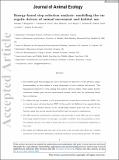Energy-based step selection analysis : modelling the energetic drivers of animal movement and habitat use
Abstract
1. The energetic gains from foraging and costs of movement are expected to be key drivers of animal decision-making, as their balance is a large determinant of body condition and survival. This fundamental perspective is often missing from habitat selection studies, which mainly describe correlations between space use and environmental features, rather than the mechanisms behind these correlations. 2. To address this gap, we present a novel parameterisation of step selection functions (SSFs), that we term the energy selection function (ESF). In this model, the likelihood of an animal selecting a movement step depends directly on the corresponding energetic gains and costs, and we can therefore assess how moving animals choose habitat based on energetic considerations. 3. The ESF retains the mathematical convenience and practicality of other SSFs and can be quickly fitted using standard software. In this article, we outline a workflow, from data gathering to statistical analysis, and use a case study of polar bears Ursus maritimus to demonstrate application of the model. 4. We explain how defining gains and costs at the scale of the movement step allows us to include information about resource distribution, landscape resistance and movement patterns. We further demonstrate this process with a case study of polar bears and show how the parameters can be interpreted in terms of selection for energetic gains and against energetic costs. 5. The ESF is a flexible framework that combines the energetic consequences of both movement and resource selection, thus incorporating a key mechanism into habitat selection analysis. Further, because it is based on familiar habitat selection models, the ESF is widely applicable to any study system where energetic gains and costs can be derived, and has immense potential for methodological extensions.
Citation
Klappstein , N J , Potts , J R , Michelot , T , Börger , L , Pilfold , N W , Lewis , M A & Derocher , A E 2022 , ' Energy-based step selection analysis : modelling the energetic drivers of animal movement and habitat use ' , Journal of Animal Ecology , vol. 91 , no. 5 , 13687 , pp. 946-957 . https://doi.org/10.1111/1365-2656.13687
Publication
Journal of Animal Ecology
Status
Peer reviewed
ISSN
0021-8790Type
Journal article
Description
Funding: The authors acknowledge funding from Mitacs Canada, the Canadian Association of Zoos and Aquariums, Canadian Wildlife Federation, Environment and Climate Change Canada, Hauser Bears, Natural Sciences and Engineering Research Council of Canada, Polar Bears International, Polar Continental Shelf Project, Quark Expeditions, United States Department of the Interior (Bureau of Ocean Energy Management), and World Wildlife Fund Canada.Collections
Items in the St Andrews Research Repository are protected by copyright, with all rights reserved, unless otherwise indicated.

